3 Steps to Connection
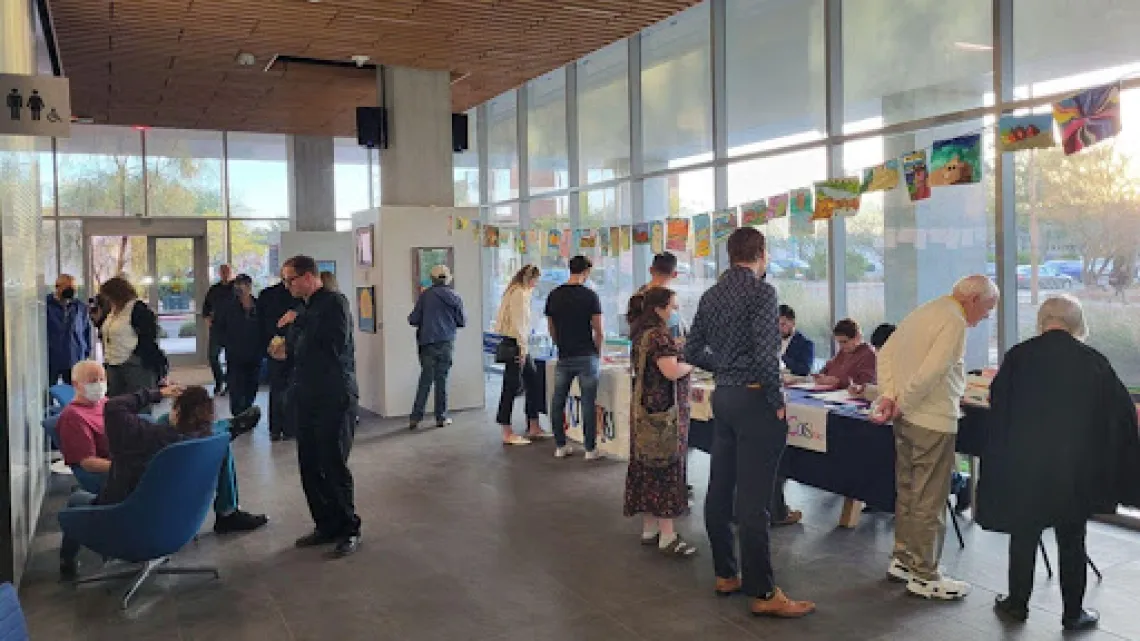
Attendees gather in at the BIO5 Institute for the opening ceremony of 3 Steps to Connection
We previously covered the beginning of a new project by ArtWorks, an outreach program housed in the University of Arizona Sonoran Center for Excellence in Disabilities, called The 3 Step Expressive Arts Project. The project began with the hope of building connections and encouraging creativity among people with disabilities, who were more likely to be isolated during the worst of the COVID-19 pandemic. Now, that project has come to fruition with the unveiling of the 3 Steps to Connection art exhibit at an opening ceremony on Friday, January 13, 2023 at the UArizona BIO5 Institute. The event was well-attended, with crowds gathering around the various art pieces, and a silent auction was held.
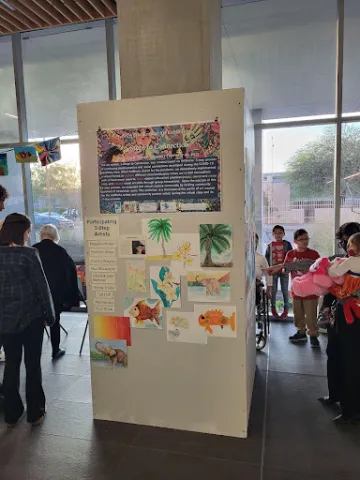
A column with several art pieces, the names of some of the artists, and a poster detailing the 3 Step Expressive Art Project
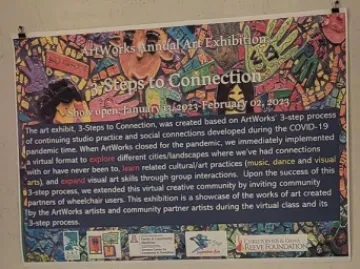
A closer view of the poster detailing the creative process of the 3 Step Expressive Art Project
The works showcased a number of local artists working with ArtWorks, including Paul McLaughlin, who also happens to be an event assistant for the Sonoran Center. His piece, Different Techniques, brought a playful, colorful touch to the event.
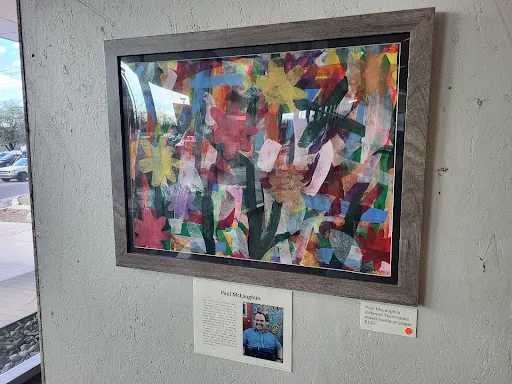
Different Techniques by Paul McLaughlin, mixed media on paper
Many of the artists were present at the event. They were each invited to give a short speech about their art pieces — discussing its themes, composition, and creative process. Some of the pieces centered around certain places that carry specific meaning to the artist, like Tucson’s ‘A’ Mountain for Joey Aschenbrenner. The piece’s vibrant colors and bold shapes illustrate the joy and wonder the mountain evokes for him.
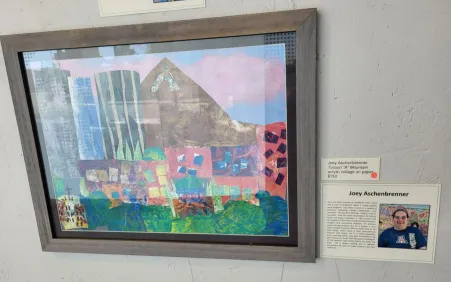
Tucson ‘A’ Mountain by Joey Aschenbrenner; acrylic collage on paper
Vicky Pisano introduced her piece My Ancestors Came From Ireland: “I did a lot of detailed work on it. I did acrylic on paper. I did a pink sky and white clouds. I hope you guys enjoy this. I also want to say ‘ello mate!’ That’s some Irish kind of talking.” Like Aschenbrenner’s work, Pisano’s painting is tied to a place with deep personal significance. Her use of high-contrast colors and wide landscape perspective lets the viewer experience the deep reverence and awe that Pisano has for her ancestral homeland.
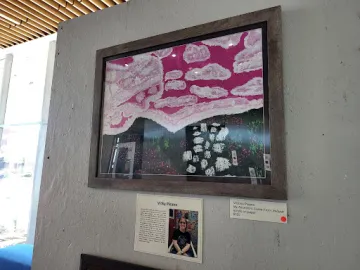
My Ancestors Came From Ireland by Victoria “Vicky” Pisano, acrylic on paper
Others explored more conceptual themes, like Carol Lynch’s piece, Nature. It eschews the obvious green and blue palette in favor of warmer pinks and reds contrasted with neutral grays and whites which ground the piece. The flock of resting birds against this backdrop bring to mind the serenity of nature in a fresh and inventive context.
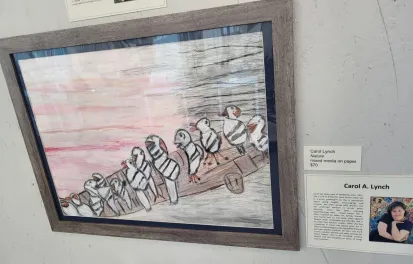
Nature by Carol A. Lynch; mixed media on paper
The Road to 3 Steps to Connection
A lot of work had happened behind the scenes to bring this show to life over the past year. The “three steps” mentioned in the project’s title refer to the three artistic mediums of the project: music, movement, and visual art. It was borne from the adjustment to virtual learning during the first months of the COVID-19 pandemic, but it has since expanded far beyond its original scope.
“The three steps, when we thought of it, was based on how Artworks adjusted during COVID times to use the virtual format by way of connection, new learning, and improving the skills they have,” said ArtWorks director Yumi Shirai, PhD.
The project’s creative process involved multiple working sessions with the artists, which included warming up with dance and music. This clears the mind and helps lift anxiety about creating art, especially if it’s unfamiliar territory. It also helps one develop connection to the subject matter - usually places “visited” via Zoom.
“We did the format of warm-up, dance, music, drawing,” Dr. Shirai said. “In order to stimulate that we selected one culture or one location to explore virtually. For instance, we went to NYC. We went to Pittsburgh to look up the rivers and bridges. We went to New Orleans to see where Jazz music came from.”
This process is evident in Jack McHugh’s The Statue of Liberty of Many Colors. The close-up view of the statue’s face against a striking orange, blue, purple, and red background gives the famous statue a uniquely human character.
“I did the statue of liberty because I like the statue of liberty. I did watercolors on the back and front, and I traced it on tracing paper, and it took me a very long time to do it. I really liked making it. I like the rainbows. I like the colors,” McHugh said of the work.
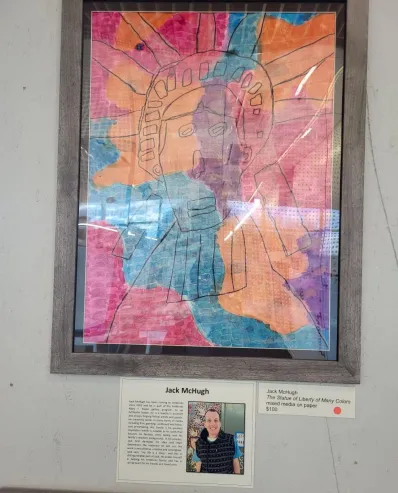
The Statue of Liberty of Many Colors by Jack McHugh, mixed media on paper
Dr. Shirai and the ArtWorks staff soon realized the potential of this model to bring different communities of disabilities together:
“I think it was a very nice way of reaching out to the extended community of disabilities,” Dr. Shirai said.
One of the project's primary goals, as the name implies, was building connections. It succeeded in this effort not only through its collaboration between multiple disability communities, but between the disability community as a whole and the wider UArizona family.
Dr. Shirai explained, “[For] someone who has communication difficulty with intellectual disability - those are the majority of our folks at ArtWorks - connecting with dance, music, and art really takes out the barriers. Not all of them, but I think it does ease up the uneasiness of getting into other communities, or having conversations. The connection we expanded through this was the realization that art can connect and share, particularly for someone who cannot rely on communication verbally or in writing.”
The pieces were impressive in their variety of medium and composition. One could find watercolor paintings, acrylics, collages, pencil drawings and more with subjects ranging from specific places or people to abstract representation of emotions and concepts.
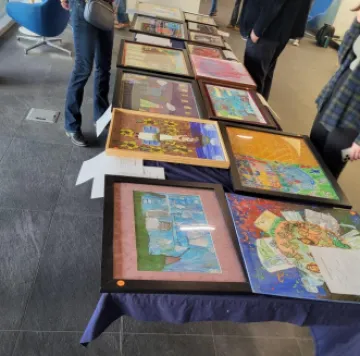
A table displaying the various pieces for sale at the silent auction
Ultimately, Dr. Shirai and the artists at ArtWorks hope this project conveys how art isn’t just for professionals or trained artists, but for everyone.
“This project kind of made people realize ‘Oh I never thought I was good at [art],’ but by participating in the process they realize ‘Maybe I can do this, and it’s very fun and enjoyable’,” she said.
“As kids, we explore everything, but then somehow as an adult we stop exploring new things or abstract concepts like creativity,” Dr. Shirai said. “You may be comfortable with cooking or different kinds of expression, but if you’re not trained in music, drawing or dance you might not necessarily be engaged with typical art, right? But I think it takes out the barriers, having this kind of fun exploration. Because particularly when we explore different cultures and interests, rather than just ‘we’re learning visual art’, you want to see different cultures, ways of living, and different places that amuse us. That really motivates us to try something new that we may not have done before.”
The 3 Steps to Connection exhibit will be available for viewing at the BIO5 Institute until February 2, 2023.
